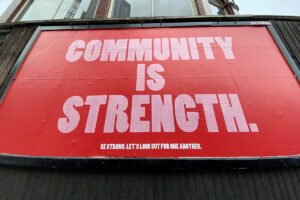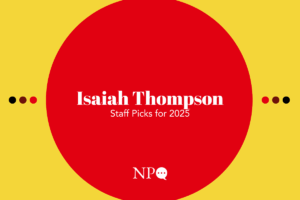
Our nation faces a severe and worsening housing affordability and supply crisis. Elevated mortgage interest rates, rising home prices, and a record-low supply of available homes are impacting local housing markets across the country. As a result, families across the nation have far fewer homeownership opportunities.
Moreover, the underproduction of single-family housing over the past decade, combined with the unprecedented escalation of home prices, is widening the racial wealth gap. Homeownership is a major driver of household wealth, yet the racial homeownership gap is worse today than when the Fair Housing Act was passed in 1968.
Closing the racial wealth gap means increasing affordable routes to homeownership—especially for borrowers of color. To achieve this requires a deeper understanding of the current housing crisis and how nonprofits can, with policy support, implement effective solutions.
What’s behind Growing Investor Dominance in Housing?
The five largest corporate owners possess 300,000 of the nearly 450,000 institutional investor-owned homes across the United States.
The housing market has always included investors, from “mom and pop” middle-class Americans renting out a single unit to supplement their income to much wealthier people who own extensive real estate portfolios. But in the immediate aftermath of the Great Recession, institutionalized private equity, such as Blackstone, began investing in large portfolios of single-family homes, holding them as long-term rentals.
This shift disrupted the balance in the housing market that had made homes affordable for many Americans. Evidence of this imbalance is overwhelming, as seen in the growing dominance of private equity in the single-family rental market.
The nation now faces an unprecedented lack of housing supply, which is driving up home purchase prices and rental rates. For example, in the fourth quarter of 2023, investors purchased 26 percent of the nation’s most affordable homes—the highest share ever recorded. In some states, such as Indiana, investor presence has increased as much as 262 percent in the last five years. As investors buy up and consolidate control of American housing stock, would-be homeowners struggle to find affordable homes amid a tightening housing supply and rising interest rates.
In fact, a recently released Government Accountability Office report indicates the five largest corporate owners possess 300,000 of the nearly 450,000 institutional investor-owned homes across the United States, a trend that has only further consolidated the market.
This trend of housing consolidation has exacerbated existing racial disparities. In 2021, approximately 30 percent of home sales in majority Black neighborhoods were made to investors, compared to just 12 percent in other zip codes. As investor-owned rental properties increase, the values of other homes in a neighborhood can decline, worsening the racial wealth gap. Today, only 44 percent of Black people own a home compared to 73 percent of White people—a gap that has grown since 2010.
A Nonprofit Solution
Before the surge in private equity interest in the single-family housing market, nonprofits were the quiet pistons in the engine of affordable homeownership. They worked on both the demand side, helping with buyer readiness, and the supply side, increasing the inventory of affordable homes in the housing market.
Nonprofit expertise and leadership have long been key to affordable housing provision. The nonprofit ecosystem includes providing counseling services for aspiring homebuyers, acquiring distressed properties, building new homes, and rehabilitating distressed properties. Nonprofits raise capital, design and implement creative and flexible financing, and help people struggling with mortgage payments stay in their homes.
This is the nonprofit housing delivery system: the sum of the efforts of mission-driven organizations to create opportunities for those otherwise locked out of the home purchase market. That system, however, has been underappreciated and undersupported—and the resulting national housing crisis is now present for all to see.
Bottom line: without the assistance and labor of nonprofits, fewer Americans would be able to purchase homes. To preserve housing affordability, it is not enough to address the rise of private equity; it is vital to bolster the strength and reach of the nonprofit delivery system itself.
Leveling the Playing Field
How is the goal of strengthening the nonprofit housing delivery system achieved?
Clearly, nonprofits need more resources to put them on a more level playing field with private equity. But it is also important simply to understand how the nonprofit delivery system has functioned historically—and then act to strengthen areas where that system is currently faltering.
It is not enough to address the rise of private equity; it is vital to bolster the strength and reach of the nonprofit delivery system.
Here it is important to understand that nonprofits have traditionally focused on the housing aftermarket—the platforms, processes, public policy, and market activity that brings distressed and defaulted mortgaged property back to market. This activity includes pre- and post-foreclosure transfers of mortgage debt, sales of mortgage notes, dispositions of abandoned property, and sales of distressed property on and outside of the traditional Multiple Listing Service (MLS) system.
Currently, about 60 percent of housing stock comprises single-family homes constructed before 1980. While new housing is needed—and nonprofits must continue to be equipped to construct new housing—it is also important to maximize opportunities for new housing supply in the existing inventory of homes.
Employing a sharp systemic focus on the nonprofit delivery of housing can also help counter overcommodification. The housing market has always included market-rate and below-market-rate housing. Below-market rate housing—more colloquially known as “starter homes”—has traditionally been managed by both for-profit and nonprofit entities, and the balance between the two has created a robust housing market with diverse options for a range of lifestyles, life stages, and funding models. This kind of housing has long provided a pathway to prosperity for millions of Americans.
Sign up for our free newsletters
Subscribe to NPQ's newsletters to have our top stories delivered directly to your inbox.
By signing up, you agree to our privacy policy and terms of use, and to receive messages from NPQ and our partners.
Restoring Balance
Of course, the nonprofit housing delivery system has not served everyone. What is important to understand, however, is that the gaps have gotten far more severe as private equity has undermined the system described above.
For example, NCST (National Community Stabilization Trust) recently surveyed several hundred nonprofits that have purchased properties with its assistance. The majority of NCST partners are nonprofits and governmental entities. The results showed that they are less active than a decade ago, meaning that nonprofit activity is being outpaced by the rise in private equity.
The dramatic increase in private equity involvement in the single-family housing market underscores the need for increased support.\
As noted above, most often, private equity investors have helped inflate the price of housing, with negative effects on housing affordability. Is there a way to turn that around?
While it is not easy, I believe it is possible for nonprofits and private equity investors to work together to ensure that as private equity-owned single-family rental homes are sold, nonprofits can acquire those properties most in need of rehabilitation before being sold to a homeowner.
One such partnership providing a model for how that can work to expand affordable homeownership involves the Atlanta Neighborhood Development Partnership Inc. (ANDP), which launched a pilot program with investment firm Pretium to increase affordable housing in Atlanta. In 2021, according to the Federal Reserve, housing in none of the 13 counties in the metro Atlanta area qualified as affordable (that is, costing less than 30 percent of average household income), and the city was 105,000 homes short of meeting regional demand.
Under this pilot, Pretium is giving ANDP the opportunity to purchase vacant homes they intend to sell before listing them for public purchase. ANDP would rehabilitate the homes they buy and resell them at affordable rates. Over the next seven to 12 years, the partnership aims to convert roughly 50 percent of these affordable rental properties into single-family, owner-occupied homes.
Amid high interest rates and housing construction cost inflation, there are economic pressures that may encourage private equity investors to “play ball” with nonprofits. Offloading homes to nonprofits makes economic sense for private investors, as interest rates and housing construction costs rise and investor opportunities to quickly flip properties become less lucrative.
In these circumstances, nonprofits are best positioned to acquire those assets for the benefit of affordable homeownership. But that will only happen if they are adequately supported and resourced. Partnerships with private equity firms might help, but policy support for nonprofits to have the funds to acquire and rehabilitate the properties is also critical to making this system work—and addressing what’s presently an enormous affordable housing shortage in far too many communities.
The Role of Policy
The housing system must change—or US housing is likely to become increasingly unaffordable.
Federal housing policy is also, of course, vital to addressing the housing crisis. The most immediate step is for Congress to pass the Neighborhood Homes Investment Act (Neighborhood Homes). Neighborhood Homes, for which NCST coleads a growing coalition, calls for the creation of a new federal tax credit for the development and renovation of single-family housing in distressed neighborhoods.
Where the Low-Income Housing Tax Credit (LIHTC) program has produced much-needed multifamily rental housing, Neighborhood Homes, if passed, would help spur the development of single-family homes. The Neighborhood Homes Coalition has estimated that $1 billion in investment would stimulate over 33,000 jobs across 25,000 new developments, resulting in $4.25 billion in development activity.
Congress has also taken an interest in restraining the rise of private equity investors in the single-family housing market. Legislation introduced by Senator Sherrod Brown (D-OH), Senator Jeff Merkley (D-OR), and Representative Ro Khanna (D-CA) aims to tackle the stranglehold of institutional investment head-on. The Stop Wall Street Landlords Act, Stop Predatory Investing Act, and End Hedge Fund Control of American Homes Act provide variations on a theme, forcing for-profit institutional divestment and implementing penalties at scale.
To further support nonprofits, Congress can also ensure that defaulted properties secured by government-backed mortgages are available for nonprofits to acquire, rehabilitate, and bring back to market in ways that increase the affordable single-family supply. Data on the size of these inventories are unclear, and Congress should ensure that the Department of Housing and Urban Development (HUD) and government-sponsored entities (Fannie Mae and Freddie Mac) regularly make these data available.
The Preserving Homes and Communities Act, reintroduced this year by Senator Jack Reed (D-RI), would codify a program that helps community buyers obtain properties in their market from government and government-sponsored entities before they go to sale more broadly. This would help make more single-family homes available to eligible households and nonprofits, as opposed to large investors—bringing to scale the types of programs needed to address the scope of the crisis.
A Reset on Homeownership Policy
To make housing affordable, policymakers and nonprofit leaders must prioritize strengthening the nonprofit delivery system. Expanding access, increasing supply, and improving affordability are all key to addressing the housing crisis.
In this struggle, private equity is often a barrier, but in the right circumstances, private investors can effectively step up and work together with mission-driven practitioners. As the housing crisis becomes more severe, it is time to bring about much-needed policy reform and expand the supply of affordable homes for sustainable development and purchase by empowering individual homebuyers and community-based nonprofits to become directly involved.
The point is simple: the housing system must change—or US housing is likely to become increasingly unaffordable. The good news is that the elements for a solution are there—if nonprofits, policymakers, and other housing actors come together and build the nonprofit delivery system that the country needs.








